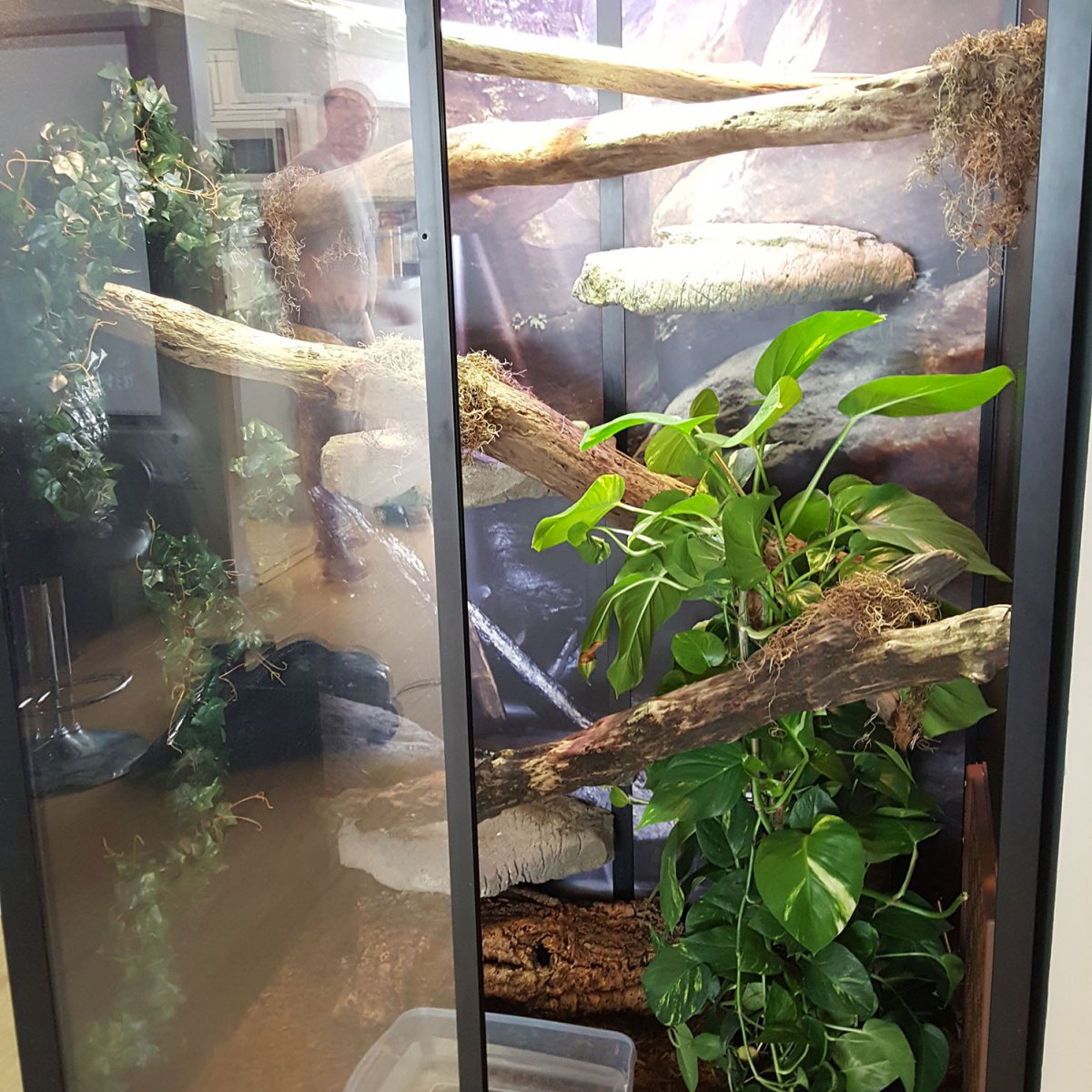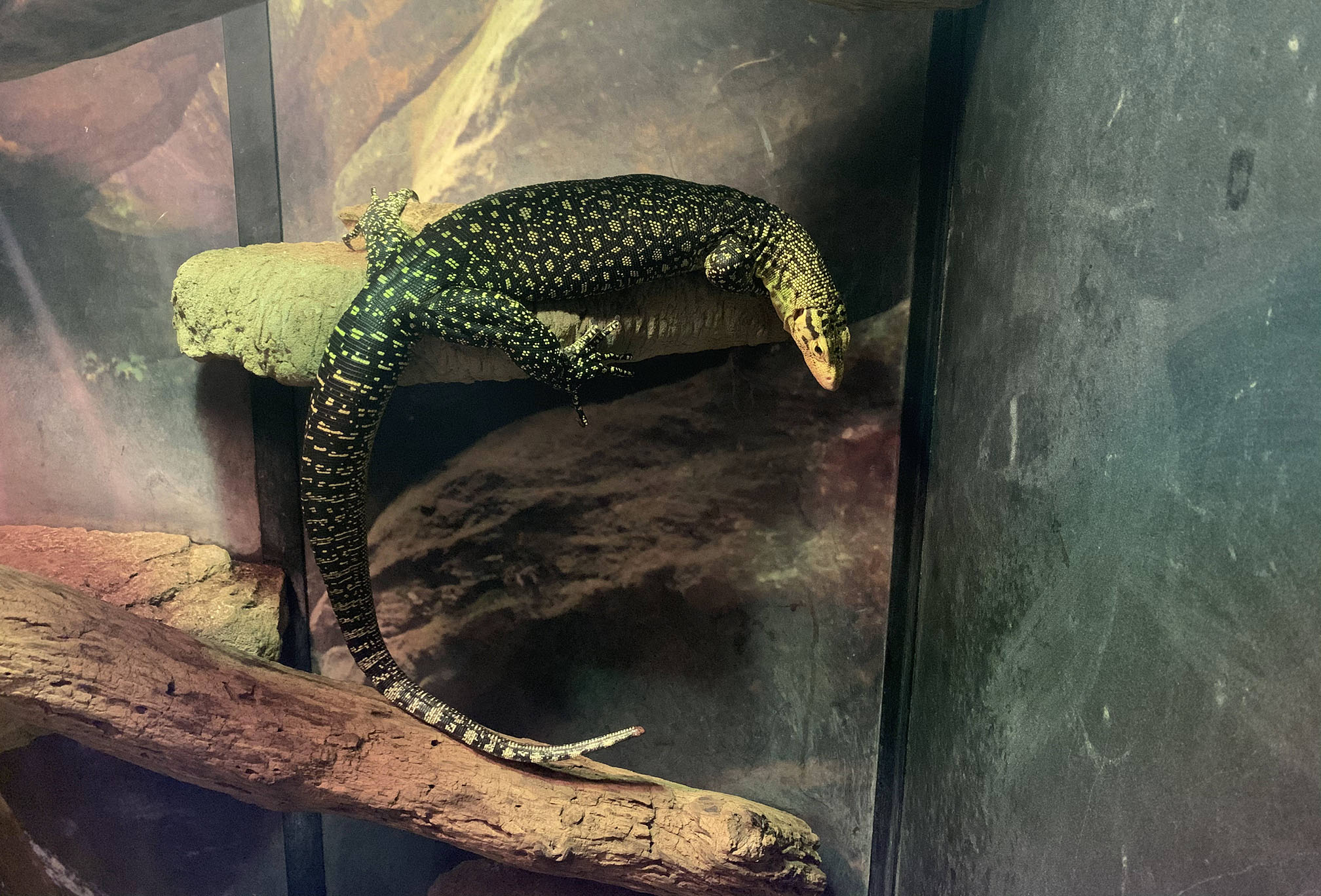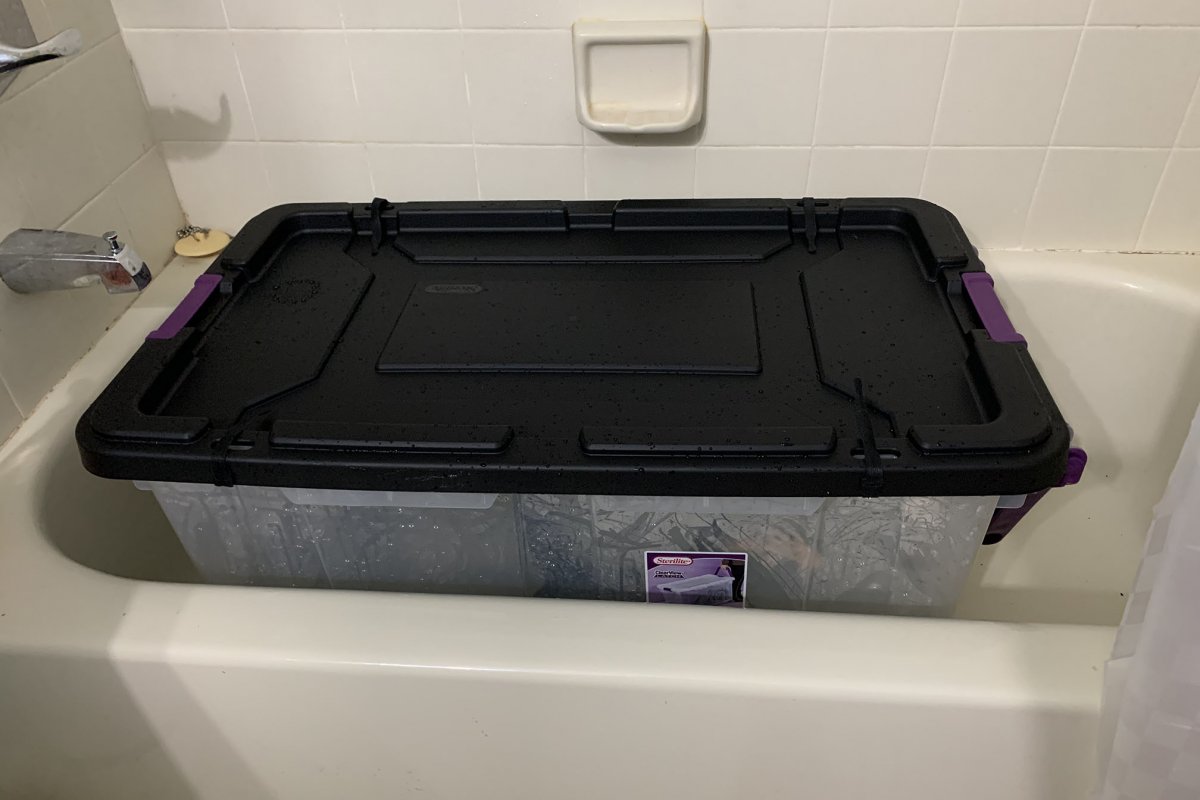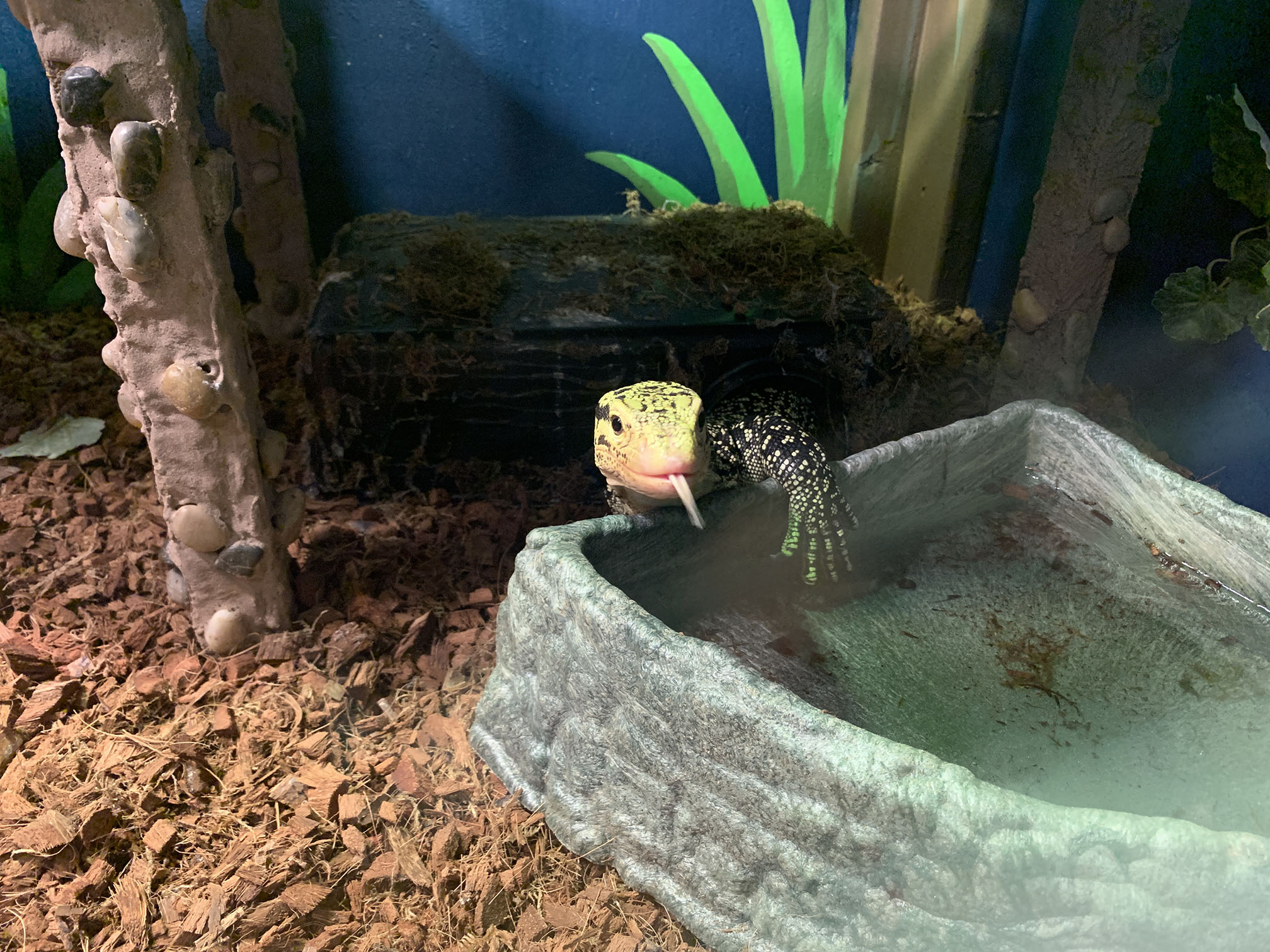One of the most frustrating things in providing a setup for Falafel was finding a balance between heat and humidity. (I thought we had escaped this in not getting a chameleon, where you need high humidity and open air. Not so!) His basking area needed to be about 115F, and his humidity needed to be 80%. The taller his enclosure, the more ridiculous this goal became. And so it was that, after we moved Falafel to his upgraded enclosure of 4’x3’x6’ (wxdxh), we started having major problems.
First, the enclosure had lots of branches and things to climb—which was great, except that Falafel loves to cannonball from heights with no regard to how far a drop it is. He would swing around a branch, and CRACK! whack his tail very hard on the side of the enclosure. Whether it was from this, or the continued battle with humidity, the tip of his tail started to break open. We consulted with a couple of exotic veterinarians pretty early on when this started to happen, but nothing we did seemed to break the cycle: his tail would bleed, then heal, then look crusty and black for a while, then break off and bleed again.
I’ve read articles about lizards’ and snakes’ tails where, if humidity isn’t high enough, the tip of the tail doesn’t shed properly and can eventually lose blood circulation and break off. Some of his shed was reluctant to come off, although it was never this obvious. Still, we soaked him regularly, vented a room-size humidifier into his enclosure, and applied betadine and/or chlorhexidine cream to his tail as needed. Sometimes he went on antibiotics, because the vet was worried an infection in the tail would cause him a systemic infection. And still it continued.
Soaking Tubs
It is worth mentioning here that while we went through these challenges, Falafel continued to grow. When he was a baby, we could give him the entire bathtub to swim in. Then, one day, he realized he could prop his foot on the tub’s overflow cover and climb out, and that was the end of that. We had to get a suitable tub for him to soak in.
We started out with a 18”x21”x9” latching tub and got on with that for a good year before he learned how to pop the latches off. We then moved to a tub with the same base dimensions but 14” tall in hopes that he would not be able to get as much purchase and open it; this thinking was flawed. It was easier for him to open it, because he was now able to stand and push on it. However, it gave him some more room, so we kept it going for a while, putting straps over the latches and then cutting holes for straps on the side of the tub when two latches wasn’t enough.
Ultimately I found this massive, beefy latching Sterilite tub at Target that measures 36x21x18 AND has built in holes for me to put straps on. He doesn’t stand a chance!...well, for now. I’m just going to enjoy myself until the day he figures this one out. He’s working on it.
Looking at Diet
In addition to trying to deal with the humidity problems, we double-checked Falafel’s diet. In addition to the tail issues, we noticed that Falafel’s mouth would bleed sometimes. Our veterinarian noted that this could be caused by trauma or bad meat. Not only that, though, but my own reading on humans and bleeding teeth and gums led to discussions on vitamin deficiencies. Frankly, it’s also possible his throat was irritated because of the humidity. We weren’t even sure if this was related to Falafel’s tail or not. So, we went over the food again.
We were offering whole meats, Reptilinks, and small frozen thawed rodents. The Reptilinks consisted of whole ground animal. For other meats, we had been ordering Blue Ridge Beef, which in addition to beef offers other meats like deer, duck, rabbit, and things that we mixed in to give Falafel lots of variety. They come in big sausage logs, which we kept frozen and would cut a slice from to put in the refrigerator. However, when we read it over again we found that while Blue Ridge Beef’s kitten mix offered muscle, bone, and organ meat, the rabbit and deer mixes were only muscle and bone. This would be fine as far as obtaining the calcium to phosphorous ratio we always look for in our reptiles, but in the absence of organ meats I couldn’t help wonder if he was losing something.
Vitamin Deficiency?
In humans, vitamin C and K deficiencies can cause bleeding gums. However, we get these vitamins from fruits and vegetables, which are not part of the monitor diet. Reptiles produce their own vitamin C, although if production was impaired it might be feasible to say that they could cause these symptoms. VeterinarianKey describes scurvy, which is caused by a vitamin C deficiency, as characterized by “poor wound healing, increased bleeding due to capillary wall fragility and bone alterations” (2017). However, the full function of vitamin C in reptiles is not well understood, and in an otherwise healthy animal, it may not play a major role at all. Similarly, vitamin K is produced by reptiles in the gut, and it seems to play a role in clotting in reptiles (this is briefly mentioned in Mader’s Reptile Medicine and Surgery, p.562).
In any case, relation of these deficiencies to Falafel’s tail problem is all speculation, but we were careful after that to alternate the meat we still had from Blue Ridge Beef regularly with our reptilinks and whole rodents. We also found another whole meat from our local supply store that includes organ meats (although it only seems to come in beef and turkey), and will continue looking for whole meat blocks/sausages going forward. Finally, we sought after a pellet food made by Mazuri that has been formulated for crocodilians and other meat-eating lizards and chelonians, and these have become part of his diet as well.
Enclosure dimensions
Our biggest change in trying to address Falafel’s tail was his enclosure. Even with the struggling efforts we made to deal with low humidity, the fact remained that his enclosure was tall enough to continually allow him to slam his tail on walls, rocks, branches and the bottom of the enclosure itself. We couldn’t rule out trauma without changing that. So, over a couple of months we worked on building him a new enclosure. It was made for higher humidity, with a pond that has running water (and continued daily sprays). The dimensions are wider than tall, giving him space without risking his safety.
The upgraded enclosure was well worth the effort. We immediately noticed a humidity difference, and a decrease in the number of breaks. Going forward, we will be huge proponents of enclosures that are wider than they are tall--even for climbing species. The control over environmental conditions is just too important.
Many months later, we started to see that Falafel's tail was beginning to heal. It looks better all the time, and we continue to monitor it and try to do our best for him.
References:
Mader, D., & Divers, S. (Eds.). 2005. Reptile Medicine and Surgery (2nd ed.). Philadelphia: Saunders Elsevier. VeterinarianKey: https://veteriankey.com/reptile-and-amphibian-nutrition/







